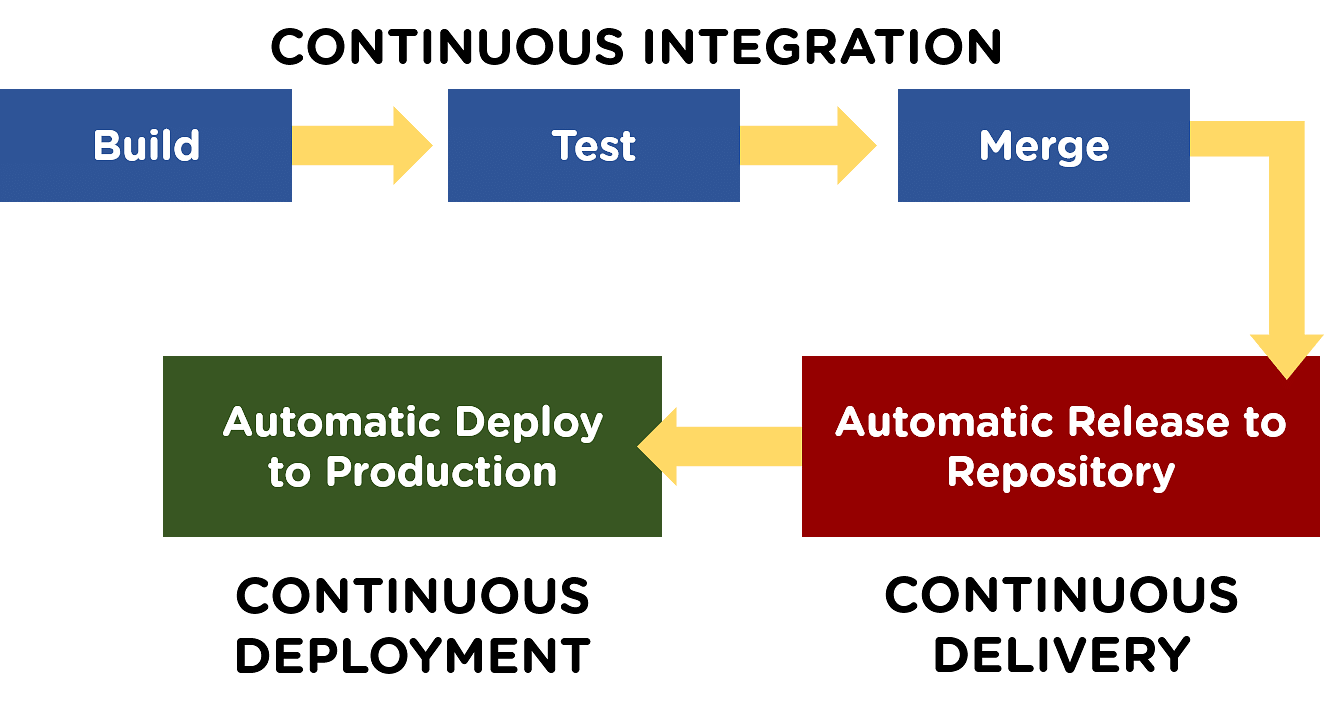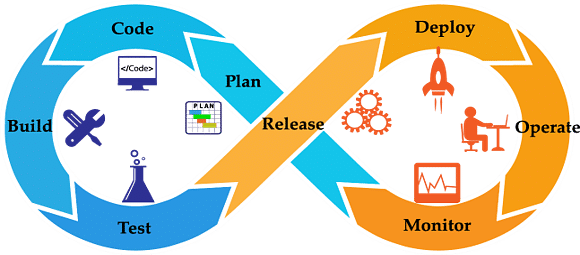Continuous Delivery vs Continuous Deployment
The practice of Modern Development is incomplete without mentioning Continuous Integration, Continuous Deployment, and Continuous Delivery pipeline. This pipeline is one of the best DevOps practices to deliver the code changes frequently and safely.
Before we go on to learning and understanding the basics of the three practices, it is essential to understand the reasons why they are referred to as the most critical DevOps practice.
Why are CI and CD Referred to as the Most Crucial DevOps Practice?
- Continuous Integration and Continuous Delivery are among the most significant practices as they create an active process of integrating and delivering the product to the market.
- Small code changes can be made in the software code, making the entire process simpler and more accessible.
- CI and CD provide continuous feedback from the customers and the DevOps team, thus increasing the transparency of any problem within the team or outside it.
- The overall process ensures the faster release of the product.
- The failures can now be detected faster and hence fixed effortlessly and quickly, which increases the speed of release.

Next, let’s talk about all the three processes in detail.
What is Continuous Integration?
Continuous Integration (CI) is a DevOps software development practice that enables the developers to merge their code changes in the central repository. That way, automated builds and tests can be run. The amendments by the developers are validated by creating a built and running an automated test against them.
In the case of Continuous Integration, a tremendous amount of emphasis is placed on testing automation to check on the application. This is to know if it is broken whenever new commits are integrated into the main branch.

What is Continuous Delivery?
Continuous Delivery (CD) is a DevOps practice that refers to the building, testing, and delivering improvements to the software code. The phase is referred to as the extension of the Continuous Integration phase to make sure that new changes can be released to the customers quickly in a substantial manner.
This can be simplified as, though you have automated testing, the release process is also automated, and any deployment can occur at any time with just one click of a button.
Continuous Delivery gives you the power to decide whether to make the releases daily, weekly, or whenever the business requires it. The maximum benefits of Continuous Delivery can only be yielded if they release small batches, which are easy to troubleshoot if any glitch occurs.

What is Continuous Deployment?
When the step of Continuous Delivery is extended, it results in the phase of Continuous Deployment. Continuous Deployment (CD) is the final stage in the pipeline that refers to the automatic releasing of any developer changes from the repository to the production.
Continuous Deployment ensures that any change that passes through the stages of production is released to the end-users. There is absolutely no way other than any failure in the test that may stop the deployment of new changes to the output. This step is a great way to speed up the feedback loop with customers and is free from human intervention.
After the basics of all three concepts, it’s essential to understand how these three processes relate to each other.
How Are Continuous Integration, Continuous Delivery, and Continuous Deployment Related to Each Other?
To understand the relationship between the three processes, we can consider a car assembly line’s analogy. In the car assembly line, it is to be ensured that the individual parts are of the best quality, and they are correctly installed. This entire process comes under Continuous Integration.
While ensuring that the assembled car is fully efficient, free from bugs comes under Continuous Deployment. If the car comes out to be as planned, and everything is implemented successfully, the entire process can now be controlled at a single push of a button. The only difference between Continuous Delivery and Continuous Deployment is that the step of delivery is made automatically.
Now, let’s have a look at all the three processes in a sequential order to understand how they are related. The CI/CD pipeline begins with the process of Continuous Integration.
- The process of Continuous Integration allows the developers to integrate code changes into a shared repository continuously. The code in this process is continually tested and incorporated more smoothly.
After the Integration phase, comes the Continuous Delivery phase.
- The changes made in the code go through several fixes and feedback before going to the next phase. The team in this phase decides what is to be deployed to the customers and when.
The next and the final phase is the Continuous Deployment phase.
- The step to Delivery and Deployment share the common goal of automating the development process. Sometimes, Continuous Delivery and Continuous Deployment are combined to yield maximum outputs.
Let us now have a look at the features of these practices.
Features of Each Practice
Now, when you know the basics of all three practices, it is essential to understand why these practices are adopted. Let’s have a look at the benefits and factors of these practices, one after the other.
Continuous Integration
- Automated tests make sure that the bugs are captured in the early phases, and fewer bugs reach the production phase.
- After the issues are resolved efficiently, it becomes easy to build the release.
- Developers are alerted when they break any build, so they have to rebuild and fix the build before moving forth on to the next task.
- As Continuous Integration can run multiple texts within seconds, the costs for testing decreases excessively.
- When lesser time is invested in testing, more time can be spent in the improvement of quality.
Continuous Delivery
- The process of deploying software is no more complex, and now the team does not need to spend a lot of time preparing the release anymore.
- The releases can be made more frequently, this in turn speeds up the feedback loop with the customers.
- The iterations in the case of the process become faster.
Now, let’s understand the features of Continuous Deployment.
Continuous Deployment
- There is no need to stop the development for releases anymore, as the entire deployment process is now automated.
- The release process is less prone to risks and is easily fixable in the case of any issues, as only the small batches of changes are deployed.
- There is a continuous chain of improvements in quality with every passing day. The process of development now does not take long durations like a month or a year.
The process of Continuous Delivery and Continuous Deployment are often confused. This happens because they both aim at automation and have certain things in common. But, here we shall discuss what makes them exclusive
Continuous Delivery Vs. Continuous Deployment
There are many common things between the two practices, but there are differences that have quite an impact on the business.
Here, we shall see the contrast between the two phases based on the following three critical aspects.
| Continuous Delivery | Continuous Deployment | |
| Definition | Continuous Delivery is a software engineering practice where the code changes are prepared to be released. | Continuous Deployment aims at continuously releasing the code changes into the production environment. |
| Advantages | Frequent releasesReleases are completed in smaller segmentsInstant responses to defects/bugsMore stable, reliable, and comfortable releases | Completion of each deployment phaseQuick and more reliable completionAutomation of the entire processCreation of the fully automated CI/CD pipeline |
| For Whom? | Continuous Delivery is more suitable for organizations that require the release of new features frequently. | Continuous Deployment is more suitable for organizations that need to release features on a daily or hourly basis. The process ensures cross-department coordination. |

Conclusion
By now you would have completely understood why these practices are referred to as the best DevOps practices. We have learned the basics of all the three practices – Continuous Integration, Continuous Deployment, and Continuous Delivery.
Not only did we learn the features of the three practices, but we were also able to seek the difference between Continuous Deployment and Continuous Delivery.



